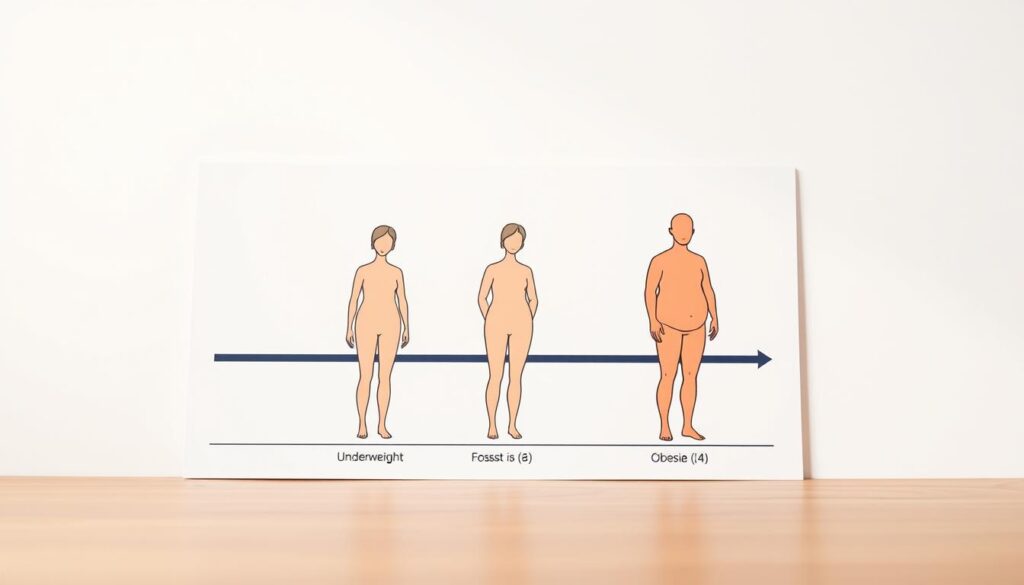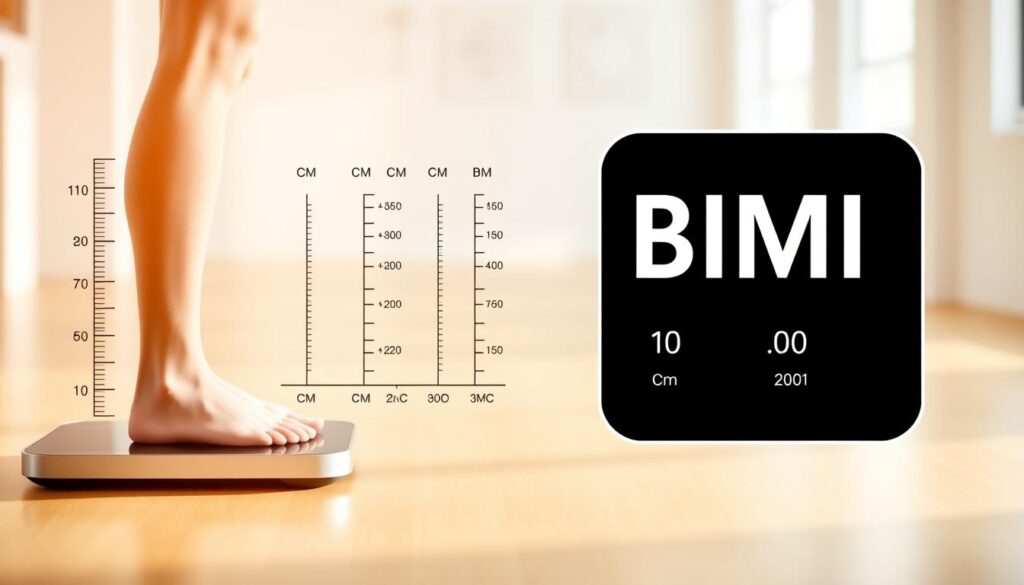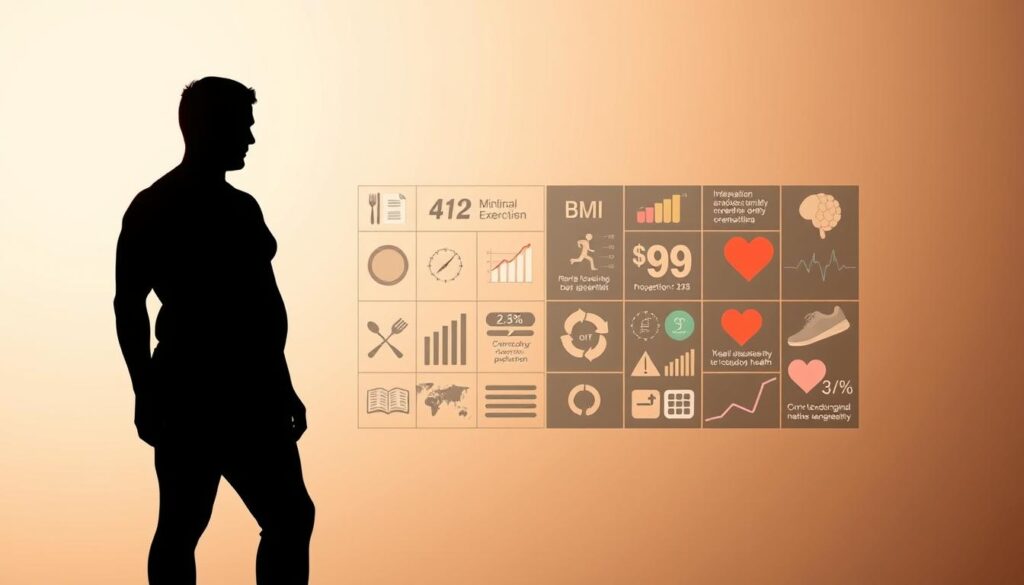What if your idea of a healthy weight is missing a critical piece of the puzzle? Many assume they’re “in range” based on guesswork, but accurate measurements matter more than you think. Let’s explore how a simple tool can clarify your health journey.
This guide focuses on a widely used metric that evaluates body composition using two factors: weight kilograms and height. By inputting these details, the tool generates a score that categorizes results into ranges recognized by global health organizations. We’ll break down how it works, why precision matters, and how to interpret your outcome.
Our approach combines formulas from sources like the CDC and WHO with practical tips. For instance, a person weighing 160 lbs (72.5 kg) at 5’10” (178 cm) would follow specific steps to determine their status. You’ll learn to avoid common errors and use this data to make informed choices about your well-being.
Key Takeaways
- Understand how body mass index is calculated using metric measurements.
- Learn why precise height and weight inputs are crucial for accuracy.
- Discover how global health standards define ideal ranges.
- Gain actionable strategies to improve measurement reliability.
- Access trusted guidelines from leading medical authorities.
Understanding Body Mass Index (BMI) and Its Significance
Health assessments often overlook a key metric that reveals hidden risks. Body mass index measures body mass relative to height, offering a standardized way to evaluate potential health concerns. Developed in the 19th century, this tool remains widely used by medical professionals today.
What Is BMI and How It’s Calculated
The formula divides weight in kilograms by height in meters squared. For imperial measurements, multiply pounds by 703 and divide by inches squared. Both methods categorize results into four ranges:
| Category | Range | Health Implications |
|---|---|---|
| Underweight | < 18.5 | Nutritional deficiencies |
| Normal | 18.5–24.9 | Lowest heart disease risk |
| Overweight | 25–29.9 | Moderate health risks |
| Obese | ≥ 30 | High chronic disease risk |
Benefits and Limitations of BMI
This method provides a quick health screening tool for populations. However, it doesn’t distinguish muscle from fat—athletes may register as overweight despite being healthy. Children use growth charts instead of adult ranges, as noted by WHO standards.
While useful for initial assessments, BMI works best alongside other metrics like waist circumference. Always consult healthcare providers for personalized evaluations, especially if you have high muscle mass or unique body compositions.
How to Use a BMI calculator with height in cm Effectively
Many people underestimate how small errors in measurement can skew health assessments. Proper technique transforms vague estimates into actionable data. Let’s turn precise numbers into meaningful insights.
Step-by-Step Instructions for Metric Units
Follow this sequence for reliable results:
- Stand straight against a wall without shoes. Measure from floor to crown using a stadiometer
- Record weight on a calibrated digital scale first thing in the morning
- Enter centimeters and kilograms directly into the tool—no conversions needed
- Review your score alongside the healthy weight range for your stature
Example: A 170 cm adult weighing 68 kg gets 23.5 (normal range). Misplacing the decimal point as 1.70 vs. 170 cm changes results drastically.
Tips for Accurate Weight and Height Measurements
- Use medical-grade devices rather than bathroom scales
- Check measuring tapes against certified standards annually
- Measure at consistent times—weight fluctuates daily
One study found home height errors averaged 1.5 cm—enough to misclassify 12% of adults. Double-check entries before calculating. For imperial users, multiply inches by 2.54 before inputting centimeters.
Key Factors Influencing Your BMI
Behind every body mass index score lies a complex interplay of biological variables. While the formula uses simple math, real-world results require deeper analysis of three critical elements.
Biological Variables That Shape Results
Age changes everything: Adults over 50 often carry more fat around organs despite stable weight. This visceral fat increases heart disease risk even when BMI appears normal. Children’s growth patterns require different standards entirely.
Gender plays a role: Women naturally have 6-11% more body fat than men at the same BMI. Hormonal differences affect where fat accumulates—a key factor in blood pressure and type 2 diabetes risks.
- Muscle weighs more than fat: Athletes may score in overweight ranges despite low body fat
- Postmenopausal women gain abdominal fat while losing muscle mass
- Teenagers need age-adjusted percentiles instead of adult categories
Research shows muscle-heavy individuals face 30% lower chronic disease risk than those with identical BMI and higher fat percentages. This explains why health organizations recommend combining BMI with waist measurements.
Consider two 40-year-olds with a BMI of 26. A construction worker might have optimal health markers, while a sedentary office worker could show early signs of metabolic syndrome. Always pair your results with activity levels and medical history for accurate interpretations.
Health Implications, Weight Ranges, and Ideal Targets
Many adults don’t realize their weight category directly impacts disease risks. Let’s examine how specific ranges correlate with health outcomes and explore tools that refine your understanding of body composition.
Breaking Down Weight Classifications
Global standards define four primary categories based on body mass-to-height ratios:
- Underweight (<18.5): Linked to weakened immunity and osteoporosis
- Normal (18.5–24.9): Lowest risk for chronic diseases
- Overweight (25–29.9): 30% higher chance of developing type 2 diabetes
- Obese (≥30): Triples heart disease risk according to WHO data
When Numbers Signal Danger
Each category carries distinct health implications:
- Underweight individuals face 20% greater fracture risk
- Excess fat increases blood pressure and artery strain
- Abdominal obesity (waist >35″ women, >40″ men) heightens metabolic risks
Beyond Basic Metrics
While useful, body mass index works best when paired with:
- Ponderal Index: Uses height cubed instead of squared—better for tall/short adults
- Waist-to-Hip Ratio: Identifies dangerous belly fat accumulation
- Activity Tracking: 150 weekly minutes of exercise reduces risks at any weight
The CDC recommends combining these tools with effective body composition strategies. Regular monitoring helps adjust nutrition and exercise plans—key steps for maintaining long-term health.
Conclusion
Your health journey hinges on precise measurements and informed insights. Using a body mass index tool helps identify potential risks while revealing opportunities for improvement. Remember to measure height without shoes and weight on calibrated devices—small errors create misleading results.
Age, muscle mass, and fat distribution significantly impact scores. Active adults might show higher numbers due to dense muscle tissue, while excess abdominal fat increases heart disease and type 2 diabetes risks. Always pair your findings with waist measurements for fuller context.
Abnormal readings signal the need for action. Those outside healthy weight ranges face 30% higher chronic disease risks. Consult professionals to interpret results, especially if athletic or over 50.
Keep “BMI calculator with height in cm” bookmarked for regular check-ins. Combine this metric with activity tracking and nutrition plans to build lasting well-being. Knowledge transforms numbers into power—measure wisely, act confidently.




